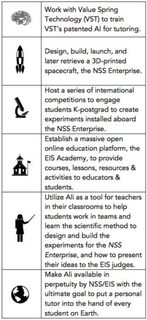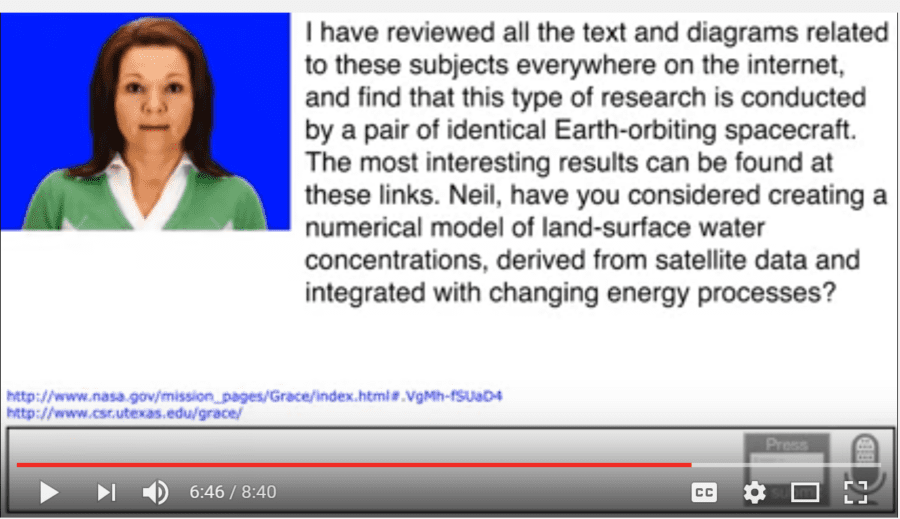Summary: A great story about an AI-powered massive on-line open learning platform focused on STEM education. The platform and its content is to be available across many languages to serve students anywhere in preparing for a better life in STEM careers.
 If you’re from the US you’re probably feeling some angst as our K-12 students seem to slip further and further back on STEM studies. Imagine how bad it is in the lesser developed countries where shortages of STEM teachers and basic tech resources make it almost impossible for young people to prepare for a better life through a tech career. Worse still, UNESCO says there are 100 million young people around the world who do not attend school at all.
If you’re from the US you’re probably feeling some angst as our K-12 students seem to slip further and further back on STEM studies. Imagine how bad it is in the lesser developed countries where shortages of STEM teachers and basic tech resources make it almost impossible for young people to prepare for a better life through a tech career. Worse still, UNESCO says there are 100 million young people around the world who do not attend school at all.
Well there is a least one story that should cheer you this holiday season and give you reason to be proud of being part of the data science community. The private sector is utilizing the specialized cognitive engine developed by Value Spring Technology (VST) along with IBM Watson to build a universal tutor and the initial focus is on STEM. When complete any student with internet access across a broad range of languages will be able to receive personalized instruction in a wide variety of subjects, starting with science, technology, engineering, math, and even the arts.
The Project has an Unusual Sponsor
 The project has an unusual sponsor with very big goals. The National Space Society (NSS) is an independent, educational, non-profit organization dedicated to the creation of a spacefaring civilization. NSS seeks to be the preeminent citizen’s voice on space, has a staff of well-regarded experts and famous sponsors, and works through 50 chapters in the US.
The project has an unusual sponsor with very big goals. The National Space Society (NSS) is an independent, educational, non-profit organization dedicated to the creation of a spacefaring civilization. NSS seeks to be the preeminent citizen’s voice on space, has a staff of well-regarded experts and famous sponsors, and works through 50 chapters in the US.
NSS leadership concluded that the lack of STEM education among the coming generation is a major barrier to a future for mankind in space and proposed a moon-shot program of their own called Enterprise in Space (EIS).
With the promise of matching funds from the MacArthur Foundation the program centers around building and launching a modest 3D-printed spacecraft to carry hundreds of science experiments from students ranging from the very young to post grads. Think of this as a giant class science project or imagination spring board as the EIS helps students formulate and conduct the space experiments then analyze the data.
While this spacecraft and the experiments are the largest and most publically tangible elements of the program, the real goal is to motivate students in STEM studies and most importantly to provide a massive open on-line education platform powered by AI.
Looking at the EIS program as a whole it’s easy to get distracted by its space focus and the audacity of 3D printing an actual workable spacecraft. For my money however, the real payoff is in the AI powered education platform that is a first in both concept and execution.
Equipping Computer Aided Instruction with Strong AI
The field of Computer Aided Instruction (CAI) actually started with the concepts of Programmed Instruction in the 70’s. The educational techniques of Programmed Instruction involve step-by-step deconstruction of the learning process with reinforcement, options for different leaning styles, branching for slower and faster learners, frequent measurement of progress, and self-pacing. These techniques moved almost seamless onto newly evolving personal computers in the 80s and 90s. CAI was seen as the future of education but it never gained the traction that was promised.
Recognizing that each student has a unique preferred learning style and that these preferences may change from subject to subject is central to the effectiveness of CAI. In the case of the NSS/EIS project, each block of learning, how the student masters a specific measurable set of skills and knowledge, is broken down into roughly 10 minute modules each of which might be delivered by several different techniques such as lecture, an activity, or even a Socratic question and answer dialogue. Each student may select a different path and pace through the learning.
In the past, the selection of modules by type was accomplished by student selection, followed by measurement of the learning, with branching hard coded into the program suggesting the student should move on or perhaps repeat using a different technique until mastery can be demonstrated. Today, however, we can use AI to automate and customize this process.
VST EnterpriseMind Platform
NSS/EIS selected VST as their partner in the project based on the strength of their AI and its unique ability to understand context. Although EnterpriseMind is built on the IBM Watson platform it takes a different path when interpreting the written or spoken inputs.
At its core Watson is categorized as a Question Answering Machine (QAM). To risk over simplifying there are two things that Watson does.
- It receives and interprets natural language inputs, text and spoken word (including foreign language translation), and responds in meaningful and appropriate phrases.
- It parses the incoming word string using a variety of algorithms to generate hypotheses of potential meaning. These hypotheses are tested against one another using weighted evidence scores returning the most likely answer from its knowledge base.
Where Watson falls short as an engine for education is in its limited ability to interpret context.
The VST EnterpriseMind platform is based on a strong AI model attempting to actually replicate how the human mind interprets and melds procedural, semantic, and episodic inputs to create the meaning for even complex concepts that humans grasp almost instantaneously. The AI embedded in the learning platform, appropriately named Ali can interact with students of almost any grade level and do some very sophisticated things:

- Ali remembers each student individually. Not only their progress but their most successful learning styles.
- Through the CAI Ali delivers information via activity, lecture, Socratic questioning or any of the other techniques available to educators.
- Ali evaluates student progress at each step offering additional information, branching, or repeats until mastery is achieved.
- The interaction with the student is occurring in spoken language both by the student and by Ali.
- Since the focus is STEM, and initially the scientific method in support of the NSS/EIS experiments, the students describe their proposed experiments and with Ali’s enhanced cognitive computing capability applied against the knowledge base, she can not only evaluate whether, for example, a hypothesis is sufficiently well defined for an experiment but can also suggest specific ways to improve it.
- In one prototype interaction, the student suggests a relatively sophisticated but overly broad experiment. Ali is able to work with the student iteratively to narrow the scope to a measurable and workable experiment. Most surprisingly, Ali could also suggest a fairly complex hypothesis and supporting experiment that the student had not thought of.
Training Watson is done with thousands and thousands of question and answer pairs and training and the creation of the knowledge base is both human intensive and time consuming. VST claims that their EnterpriseMind cognitive computing platform, which does not use this same training protocol, is much faster to train.
Bill Doyle, the founder of VST and the originator of the AI in EnterpriseMind explains that the analytics used are based on dynamic neural nets, similar to recurrent neural nets in that they regard each input element as related to those that came before and after (as in words in a string of speech). The key difference appears to be that Dynamic NNs define the required number of hidden layers for themselves.
He explains this analysis has allowed EnterpriseMind to more closely emulate the way humans convert inputs into knowledge and understanding. It is also the key to Ali’s contextual ability to deal with broad abstractions such as elements of the scientific method or even to address questions such as ‘what does it mean to be human’.
This appears to be a definite step up from Watson (VST is an IBM Watson partner) and allows AI to become a key component in personalized, self-paced education for everyone. The Ali platform is scheduled for rollout to NSS/EIS in the second half of 2017. Beyond this is the prospect of a deeply disruptive and much superior process for delivering education, one-on-one, wherever the student is, and whatever their current knowledge and capabilities. That’s something to look forward to.
About the author: Bill Vorhies is Editorial Director for Data Science Central and has practiced as a data scientist and commercial predictive modeler since 2001. He can be reached at:
